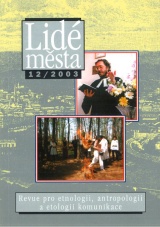,,Domácí oltáříčky"
Vztahování se k zemřelým příbuzným ve městě a na vesnici (Praha a Černošín)
DOI:
https://doi.org/10.14712/12128112.4334Abstrakt
Research of "household altars" in the Czech Republic or Czechoslovakia has mostly stood outside the central focus of anthropology. Although this is not a common phenomenon, it has turned out that it is relatively widespread, especially among the older generation. Based on a pilot survey of this cultural phenomenon, conducted in Prague and Černošín in the Tachov region in the summer 2003, one can describe the "household altars" on two levels: as a sample of artefacts connected with a deceased person and a sample of ritual acts, bound to the recollection of the late person within a family. In most cases, the dominant part of the "household altar" is constituted by the photograph of the late, which creates the "core of the altar". Around the core, there are often situated other things, usually flowers and sources of light (candles or small lamps), in rare cases also a small wreath or a black ribbon. According to the localisation of the "household altar" in the room, one can distinguish the open, closed and frame types. ln a flat or house, it is most often situated in the living room or the bedroom, exceptionally in thee "banquet room". ln connection with "household altars", one can come across three types or ritualised acts: the lighting of candles (or small lamps), laying of flowers and communication with the late, while there are two differing approaches to their execution. More often, this is only done at holidays, either connected with the late person (such as birthday, anniversary of death, the name-day, etc.) or general ones (such as Christmas, Easter, All Souls' Day, etc.). Less frequently, these acts are performed whenever the relatives remember the late, without any apparent connection with any holiday. A broad array of reasons leading to the creation of a "household altar" and the execution of the above mentioned ritualised acts, ranges from the preservation of ffamily tradition, the expression of recollection of the late and homage paid to his memory to the effort at establishing a contact with the late in order to repudiate the feeling of solitude. There is also the effort at ensuring a "magic" protection and help of the late relative. The survey has shown that "household altars" have not only a primarily reverent function and the associated aesthetlc function, bur also often fulfil the psychotherapeutical function and in some case even a magic and superstitious function.
Stahování
Publikováno
Jak citovat
Číslo
Sekce
Licence

Tato práce je licencována pod Mezinárodní licencí Creative Commons Attribution-NonCommercial-NoDerivatives 4.0.


